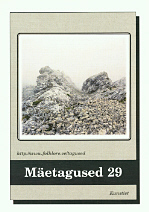Elus esinevad asjad. Popkunst lääne eeskujul argipäeva dokumenteerijana
Things in life
Author(s): Anneli PorriSubject(s): Fine Arts / Performing Arts
Published by: Eesti Kirjandusmuuseum
Summary/Abstract: Pop art, which emerged in the UK and the United States in the 1960s, depicted media objects, mundane daily life and consumer goods. Many have agreed that the critical turn in pop art is marked by the 1956 collage "Just What Is It that Makes Today's Homes So Different, So Appealing?" by Richard Hamilton. In this collage the artist combined materials advertising various consumer goods, comic strips and interior design. By the end of the 1960s, pop art as a visual style also emerged in the creative works of Estonian artists and designers. The first elements appear in the creation of the group of artists Visarid; authentic pop elements are also used by the artists of SOUP 69. The article observes the mundane banality of life in the Soviet Estonia and how and whether it is expressed in fine arts by means of pop art. Opportunities for working with the visual style after a long period of cultural and political isolation came with what was called "Khrushchev's thaw". During this period the exchange of information with the Western world improved considerably; in 1965 the sea route between Helsinki and Tallinn was reopened after twenty five years. Also, the Estonians living in the Northern part of the country could expand their horizons by watching the Finnish television. In Great Britain and America, pop art shocked people accustomed to versatile living environment by transgressing the line between good taste and bad taste. Until then art aimed to counterbalance the routine and mundaneness of everyday life, providing the artists an aesthetic oasis and keeping the circle of literati with good taste closed. In the Soviet Union this kind of critique was inconceivable, since pop art promoted what people lacked in daily life. The Soviet planning economy was unable to supply the population with commodities, which led to a strong fetishising of the western goods. This led to the gradual construction of an identity that was based on being opposed to everything Soviet, and was expressed in the attempt to imitate westerners in both behaviour and clothing. Proceeding from the aesthetics and the choice of topics, pop art could be unmistakably associated with the Western society and was therefore publicly condemned. Still, people found ways to put the alluring visual language into proper use: the one-dimensional and transparent aesthetics of pop art was most convenient to apply in the so-called small media: areas of art that remained in the periphery outside the art hierarchy, depicting, among other things, objects characteristic particularly of pop art. Theatre design (Leonhard Lapin), illustrations for youth magazines (Ando Keskküla, Andres Tolts) and animated cartoons (L. Lapin, A. Keskküla, Rein Tammik) were the most suitable and extensive sublimation channels for talented designers and architects.
Journal: Mäetagused. Hüperajakiri
- Issue Year: 2005
- Issue No: 29
- Page Range: 9-30
- Page Count: 22
- Language: Estonian

